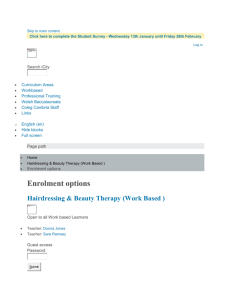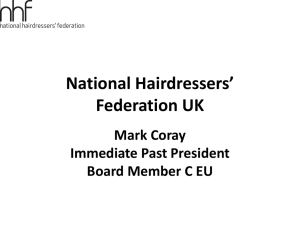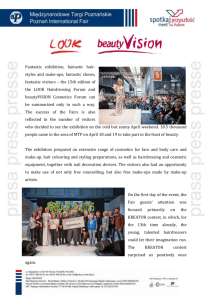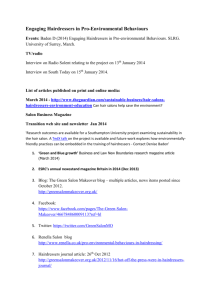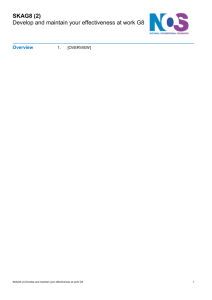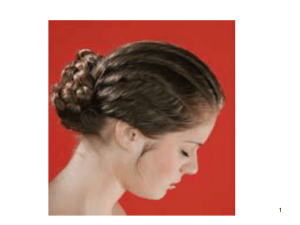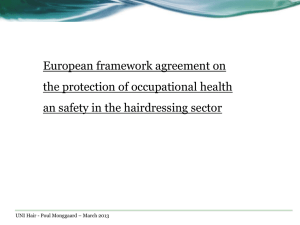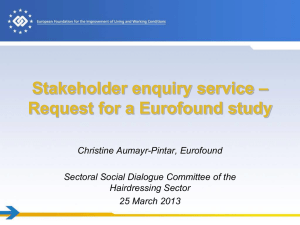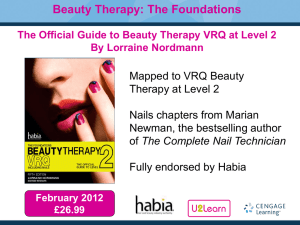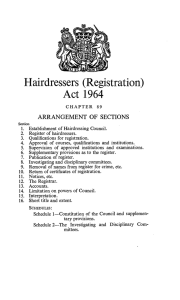Presentation Close Shave
advertisement
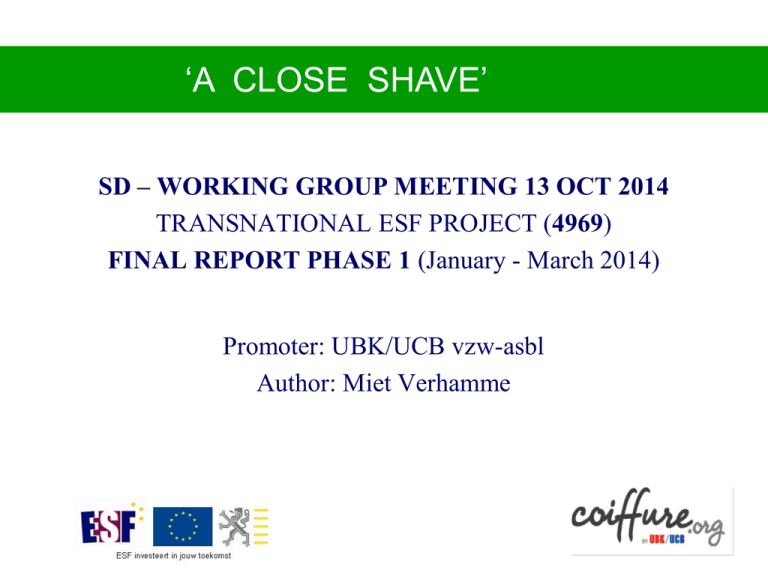
‘A‘Op-één-haar-na’ CLOSE SHAVE’ SD – WORKING GROUP MEETING 13 OCT 2014 TRANSNATIONAL ESF PROJECT (4969) FINAL REPORT PHASE 1 (January - March 2014) Promoter: UBK/UCB vzw-asbl Author: Miet Verhamme POINTS TO DISCUSS • • • • • • • • • • Motive behind the project Background to the project Method desk research Problem of health and safety Risks linked to the workplace Occupational illnesses and diseases Scope of the research Individual countries Discussing a few examples Conclusion MOTIVE BEHIND THE PROJECT Danish research: Anne Bregnhoj, Prevention of hand eczema among Danish hairdressing apprentices, (2011). Croatian research: Marija Kujundžić Brkulj, Jelena Macan, Skin Protection at Work in Croatian Hairdressers - Archives of Industrial Hygiene and Toxicology 2013 Vol: 64(2), p 295-303. BACKGROUND OF THE PROJECT Transnational European Social Fund (ESF) project Phase 1: desk research (descriptive) – 3 m Phase 2: transnat. comparisons (study trips, peer reviews, creation of training programme) – 15 m (April 2015) End result -Practical training to generate awareness for beginner hairdressers – more than just skin problems! -Supporting informative material Phase 3: test experiment in Flanders – 6 m METHOD DESK RESEARCH •Research via documentation •Contact members of Coiffure EU (good practices) •Contact all European OSHA officers •Circulate request via European Network for Workplace Health Promotion (ENWHP) PROBLEM OF HEALTH AND SAFETY General thoughts General problem •Increasing tertiary sector and ageing of the population Problem among hairdressers •Occupational illnesses are more prevalent in the hairdressing sector •Large turnover in staff •Reasons for leaving the sector •High social security costs (government) •General lack of awareness about health and safety •Personal distress and loss of income RISKS LINKED WITH THE WORKPLACE •Physical stress •Chemical products and substances with allergens •Humid environment •Use of wrong equipment •Insufficient attention to the design of hairdressing salons (ventilation, lighting, etc.) •Noise •Poor dietary habits •Irregular and long working hours OCCUPATIONAL ILLNESSES AND DISEASES • • • • • • • • Skin complaints (hairdresser’s eczema, allergy to nickel, etc.) Musculoskeletal disorders (MSD) Back complaints Respiratory problems Rheumatic complaints Repetitive Strain Injury (RSI) Poor circulation, dizziness, etc. … SCOPE OF THE RESEARCH • • • • Good Belgian examples European measures Good European examples Good examples from individual countries 17 INDIVIDUAL COUNTRIES - Denmark - Poland - Croatia - Ireland - Germany - Malta - France - Spain - Austria - Cyprus - The Netherlands - Finland - Switzerland - Italy - Latvia - Sweden - Great Britain A FEW EXAMPLES EUROPEAN •Uni Europa: creation of an app for smartphones INDIVIDUAL MEMBER STATES •Belgium: Risktrainer programme, ESF project ‘Practicability’ (sector-specific hardcopy manual with OIRA tool, campaign to generate awareness about good pregnancy policy, work differentiation tool, balance between private and professional life), etc. •Denmark: telephone hotline for hairdressers, Health and Safety training programmes: taught and trained at school. •Croatia: H&S: included in school curriculum, free workshops, e.g. ‘Your hands are the most important tool’, etc. A FEW EXAMPLES INDIVIDUAL MEMBER STATES •Germany: BGW (insurance company): special training centre for hairdressers: Studio 78 (Bochem), Hamburg: website and free online database ‘KomNet Arbeitsschutz’, etc. •France: Mixtilinear-ErgoCoiffure training, Document Unique training, etc. •Austria: ‘Safe Hair goes to school’, Start!klar, etc. •The Netherlands: short- and long-term training programmes Kapperspoli, digital test hand eczema, etc. •Switzerland: training for employers (4 employees) about safety manual A FEW EXAMPLES INDIVIDUAL MEMBER STATES •Latvia: job training H&S for schools, manual, etc. •Great Britain: hairdressing website Health & Safety Executive (HSE), 'Bad Hand Day?’ campaign, etc. •Poland: Vocational training – Health and Safety for starters, employers, employees, etc. •Ireland: Taking Care of Business, BeSMART.ie, etc. •Malta: Inspection campaign for the hairdressing sector, etc. •Spain: National inquiry into working conditions in the hairdressing sector •Cyprus: actions in relation to first OIRA tool, etc. A FEW EXAMPLES INDIVIDUAL MEMBER STATES •Finland: Evaluation plan ‘The ergonomic workplace method’, etc. •Italy: Anti-smoking campaign (flyers, posters) •Sweden: Systematic environmental (SAM) Project CONCLUSION • Increasing efforts being made in different countries Provision of information Tools Participative and interactive initiatives Awareness generating campaigns • Most important focus: prevention for and protection of the skin • More extrinsic than intrinsic motivation Consequence: importance of integration into the learning process Learning process: practice-oriented, real life, dialogue, reflection CONCLUSION Important to develop further preventive strategies for: •Beginner hairdressers •Hairdressing employees •Employers •Sector •Labour market •Government INFORMATION UBK/UCB vzw-asbl Miet Verhamme Coordinator European Policy and European Projects Vijfwindgatenstraat 21 F 9000 Ghent miet.verhamme@coiffure.org 0032 471 77 07 87
